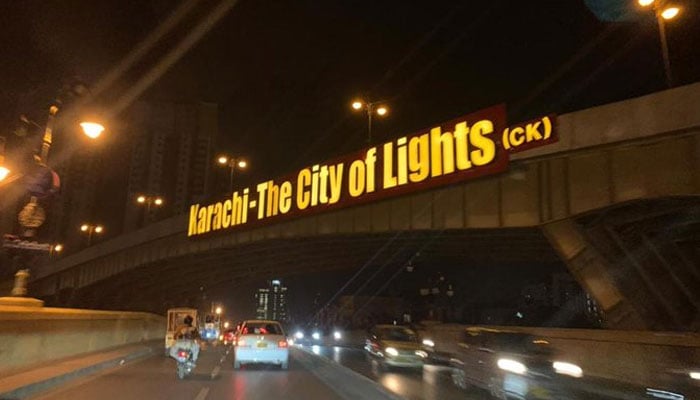The sturdy pre-partition Clifton Bridge of Karachi has only been restored by putting illuminating letters which say ‘Karachi – The City of Lights’ by the commissioner of the city, Iftikhar Shallwani. One should have gone and address the mess under the bridge.
Architecture Marvi Mazhar highlighted this at an Adab Festival session, titled ‘Karachi’s Urban Planning, Public Spaces, and Garbage Management’, on Saturday morning. Karachi Mayor Wasim Akhtar, who was supposed to be part of the panel discussion, was conspicuously missing. Federal Minister for Maritime Affairs Ali Zaidi and law adviser to chief minister Murtaza Wahab also couldn’t make it to the session. Sindh’s information minister, Saeed Ghani, was the only politician in the session.
Installing wooden boards in the red zone area saying ‘Up Town’, ‘Down Town’, ‘Karachi My Kind of City’, Mazhar believes that is tantamount to seeing Karachi through the lens of superficiality. There are six to eight centres. How do you manage it? “With this comes a very heavy notion of public spaces. How do people negotiate and interact with public spaces?” she asked.
In Karachi there are timings for parks: from 6am till 9am and then from 4:30pm till 9pm. “In the rest of the world, parks are thoroughfares, spaces where you can cross by, but here we have fences and gates [installed at the boundary of the parks].” The designing of public space, she lamented, is devoid of any study or research, but is based on the whims of the government.
Giving the example of Jehangir Park, opposite the Empress Market in Saddar, she shared how they had constructed amphitheater, but no cultural programmer. “Who does that amphitheater serve when there are no plays or acts being conducted there?” she pointed out. There’s another added ghost library inside the park. “Already there are several libraries which are termed ghost libraries in the city. Dust gathers there on books.” As for the Empress Market, she said, it was believed it would be converted into a museum or a library by the government.
There have been “painful meetings” in this regard in which it has been explained to the government that in the rest of the world, organised markets, markets of spices, exist, which also serve as tourism spots. A structure has been designed in front of the Empress Market by the government, which has turned into a parking lot, but apparently it was supposed to become a smart city-like bazaar that exists in Singapore and Bangkok.
“If you want to have a viable society, you have to have a socially just society,” said urban planner and expert on urban resilience Farhan Anwar. “A city cannot be a resilient city unless all of the citizens believe that the city is giving them back.”
How can one talk about a resilient city if 50 per cent of its population is denied citizenship rights? Karachi is a fragmented and segregated city, decentralised in all the wrong ways. Coming to the planning of the city, Anwar shared that master planning in its traditional sense is now a dinosaur of the past. “Nowhere in the world are master plans being formulated where macro-level planning is being done. They’ve brought planning down to the neighborhood level. When we talk about a modern-day sustainable city, the core of that city is a smart neighborhood,” he stressed.
Ghani, meanwhile, resorted to putting the blame of the mess of Karachi on public as well as on the government. The city, he said, had been livable before some forces captured its control by force, but now the city had got rid of the phenomenon of capturing the city by force.
As for those who have lost their homes in massive anti-encroachment drives that took place in the last few years, he said that it is not possible for the Sindh government to provide them alternative places in one year. The provincial minister said that they could not remove thousands of people on court orders.
The institutional damage of the city, according to architect and urban planner Arif Hassan, has taken place “systematically”. Everything was centralised with corrupt practices such as land grabbing, and there is a dire need for training in different institutions of the city.
He recalled how there used to be a metropolitan training institute which, he thought, shut down by 1981. Then there was the Karachi Master Plan group of office which used to conduct researches on the city. “It didn’t formulate much good policies, but at least it did something,” he said and lamented that it was not there anymore.
As for the encroachments, particularly removed from the surroundings of the Empress Market, he said the court had issued an uninformed order. “It has resulted in poverty, misery – the city is further divided,” he pointed out.
As for the efforts being made to formulate Sindh Urban Regional Master Plan Authority, he shared that from Karachi to Hyderabad, the big developers and powerful elements had taken the land for mega projects, which had also resulted in severe environmental degradation. “Which regional plan will the government make?” he asked. “You have to accept all these [realities] when you make a regional plan.”
Publish in The News By Oonib Azam 02 February 2020
Tags:
Karachi
